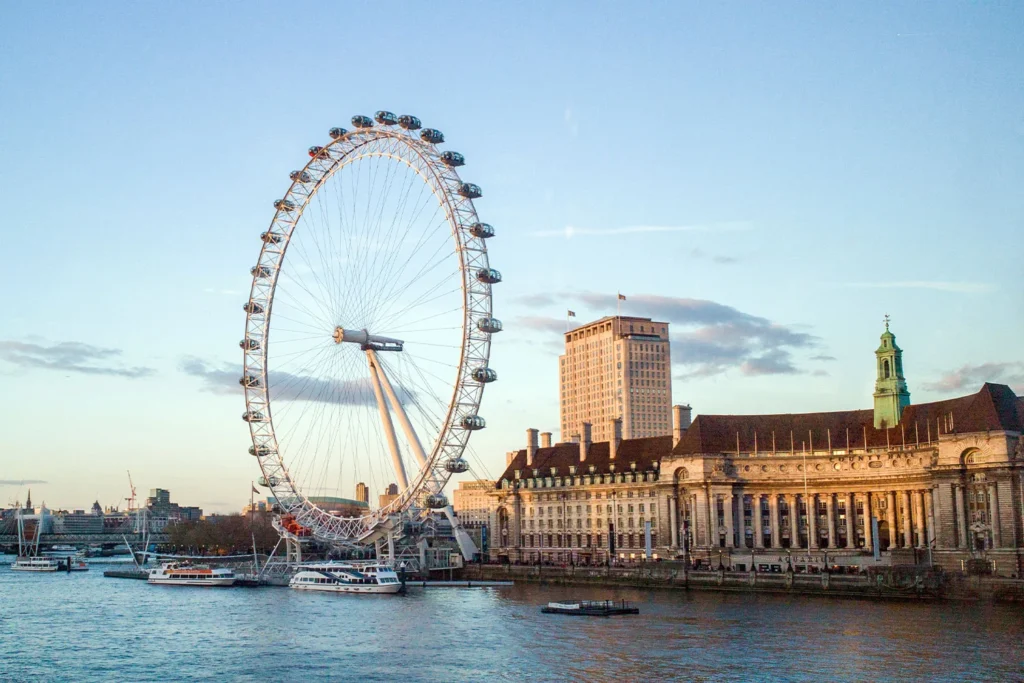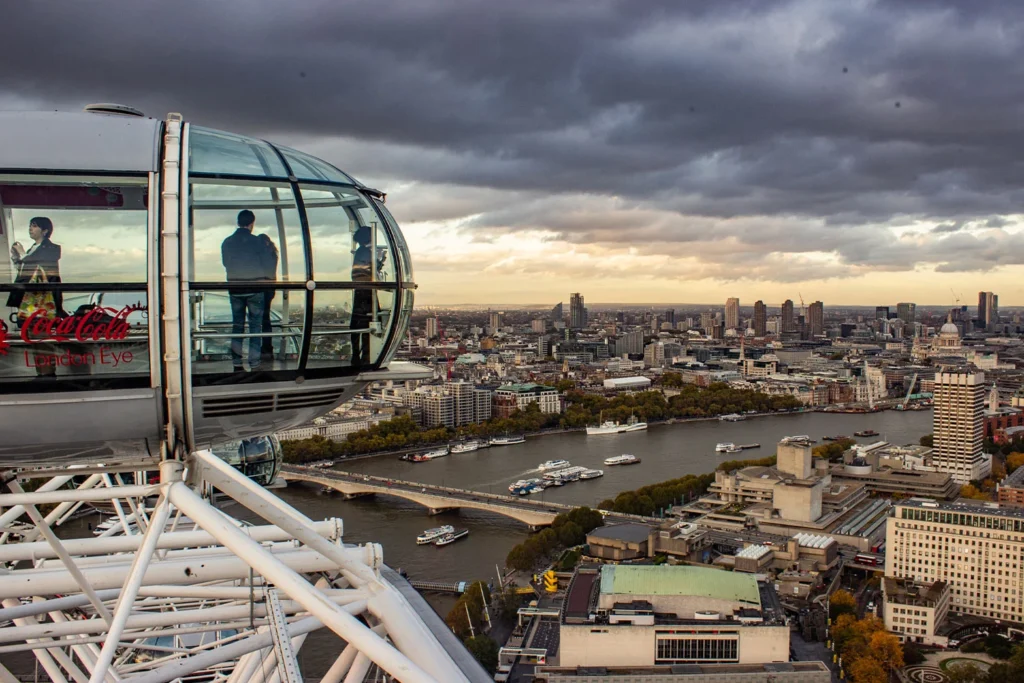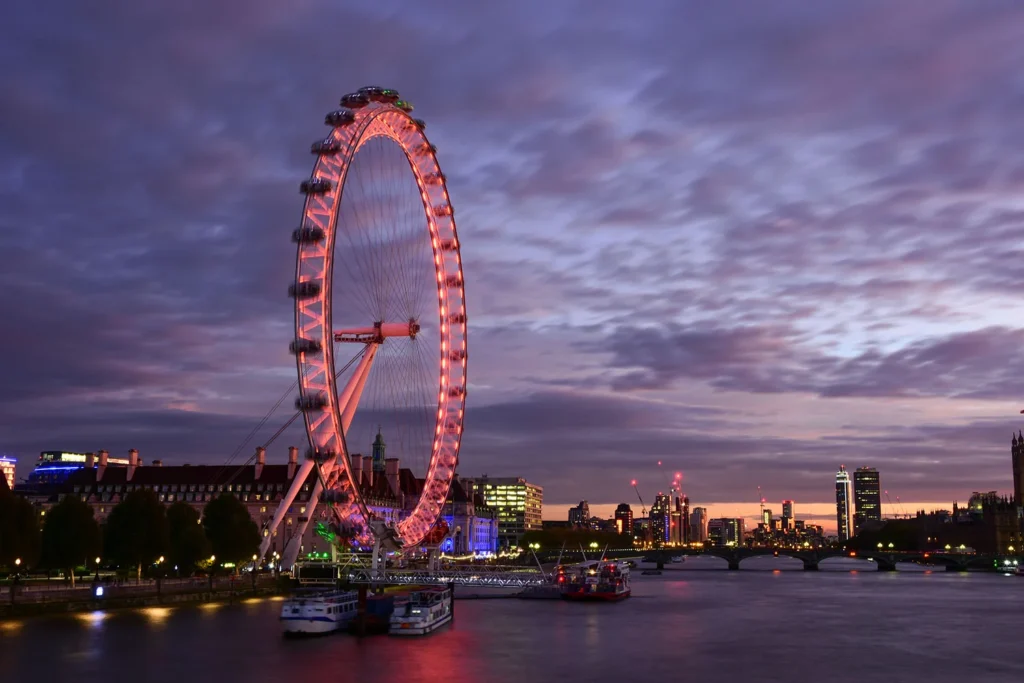Many European capitals have their own distinctive skyline, shaped by iconic buildings. But only one of them can consider a structure, most often associated with a theme park, as its signature landmark.
London Eye is undeniably the most famous observation wheel in the world. The structure, standing on the south bank of the Thames between Westminster and Hungerford Bridges, has become a symbol of the UK capital and a distinctive part of the city’s skyline. To this day, London Eye remains the largest and heaviest structure of its kind. One of London’s most iconic landmarks, it has also won over 80 awards, celebrating its exceptional architecture, engineering achievements, and its significant contribution to both national and international tourism.
History of London Eye
Where did the idea for such an extraordinary structure in London come from? London Eye was one of three structures (alongside The O2 Arena and the Millennium Bridge) erected in the capital to celebrate the dawn of the new millennium. The project for the observation point was sponsored by The Sunday Times and Great Britain’s Architecture Foundation, and among the proposals was a submission by Marks Barfield Architects. This firm ultimately took on the entire project, with the unique design spearheaded by David Marks, Julia Barfield, Mark Sparrowhawk, Malcolm Cook, Nic Bailey, and Steven Chilton.
Construction of the London Eye began in 1998, and a year later, on December 31, 1999, then-British Prime Minister Tony Blair officially inaugurated the London Eye, ushering the city and the world into the new millennium. The project was initially intended to be temporary, with plans to dismantle the structure in 2005. However, due to the immense popularity of the attraction, it was preserved. Decades have passed, and this one-of-a-kind London observation point continues to remain a top attraction, taking thousands of tourists on a remarkable journey every day. Annually, around 3.5 million tourists visit the London Eye, making it a standout destination compared to other well-known tourist spots in the city.

DID YOU KNOW: London Eye is not the official name of this famous observation wheel. Depending on the brand sponsoring it at any given time, it has been known as the Coca Cola London Eye, British Airways London Eye, and The Merlin Entertainments London Eye. Another nickname for this structure is the Millennium Wheel.
London Eye in Numbers
The London Eye stands at 135 meters high, with a diameter of 120 meters, making it the largest cantilevered observation wheel in the world. The wheel is equipped with climate-controlled passenger capsules, ensuring a comfortable ride regardless of London’s famously unpredictable weather. There are 32 capsules on the wheel, each capable of holding 25 passengers. When boarding a capsule, there’s no need to worry about swaying or sudden movements, as the mountings allow the capsule to remain upright as it rotates with the wheel. Interestingly, the wheel rotates so slowly that it doesn’t need to stop for passengers to board and disembark (except for disabled passengers).

The slow rotation of the wheel gives passengers plenty of time to enjoy the panoramic view of the English capital. On a clear day, riding the London Eye offers a chance to see all the iconic buildings within a 40 km radius. It’s a perfect opportunity to admire landmarks like Big Ben, Buckingham Palace, and other emblematic city sights, as well as Windsor Castle, located further afield. For several years, the London Eye proudly held the title of the highest viewing point in London, but in 2012, this title was claimed by the observation deck of The Shard skyscraper.
FUN FACT: The number of cabins on the London Eye is no coincidence. Their total, 32, corresponds to the 32 boroughs that, along with the City of London, make up the Greater London area.
Observation wheel or Ferris wheel?
While the popular London Eye is often referred to as a Ferris wheel, this term is technically incorrect. The main difference between a Ferris wheel and an observation wheel lies in the way the cabins are mounted. On a Ferris wheel, the cabins are suspended from the rim of the wheel, whereas on observation wheels, like the London Eye, the position of the capsules must be mechanically stabilized, making the structure more complex.

London Eye is the largest cantilevered observation wheel in the world, but it is no longer the tallest Ferris wheel since Ain Dubai, standing 250 meters high, claimed that title in 2021.
What you need to know about London Eye?
When searching for tickets for a ride on the London Eye, you’ll come across two types of tickets. Standard tickets are slightly cheaper, while the more expensive fast track option allows you to use a less crowded entrance. Regardless of which ticket you choose, it’s best to purchase them in advance, such as through GetYourGuide, as online tickets can be up to £10 cheaper than those bought on-site.
Wondering how long the ride lasts to better organize your time in London? The actual ride on the London Eye takes about 30 minutes, with the highest point reached around the 15-minute mark, offering the most spectacular views of the surroundings. However, you should account for time spent in the queue, which will likely vary depending on the type of ticket you have.
If you’re interested in more exclusive ways to experience the London Eye, you can rent an entire cabin for yourself and even order champagne to enjoy the stunning city panorama in an even more luxurious atmosphere.
Practical information
- It is best to purchase tickets for the London Eye ride in advance. This way, you can avoid standing in long lines and reduce the risk of tickets being sold out.
- Address: Riverside Building, County Hall, London SE1 7PB, United Kingdom
- Buy tickets on GetYourGuide